Uploading sketches to Arduino via Bluetooth
When programming the Arduino, it is sometimes desirable to do without a physical connection via USB to a computer, for example:
On the Internet you can find several publications on this topic, but all of them are fragmentary and there is no completely ready solution. Also, despite the simplicity and obviousness of the design, there are several small difficulties that are ready to thwart the whole event. About how to overcome them, I want to talk in this article.
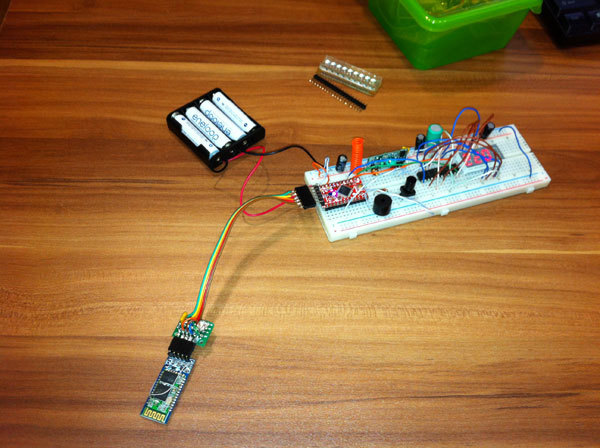
I used the cheapest Bluetooth-modules with the straightforward name "Bluetooth-module HC-05 (HC-06)". On ebay they can be found from 200 rubles. apiece, in domestic stores - from 500 rubles. I advise you to take the module already soldered on the adapter "for the Arduino", the difference in money is minimal, and saves time on assembling the interface circuit.
')
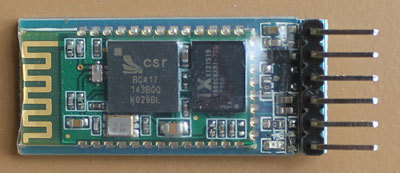
We need HC-05, but since it is extremely difficult to visually distinguish them, there is a great chance that HC-06 will be in the hands, even if the package says “HC-05”, as it happened to me:
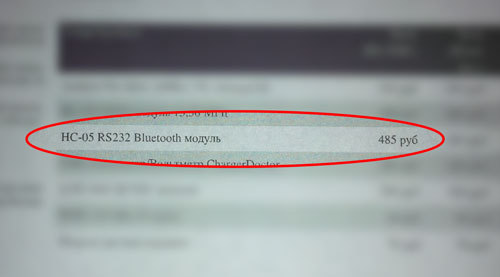
Fortunately, HC-06 can be reflashed in HC-05, but you will have to find a computer with an LPT port and spend a few hours. Instructions for flashing can be read here . From myself I want to add that the firmware did not take place under Windows7, I had to install Windows XP, and also in the BIOS, change the LPT port mode to EPP 1.7.
So, we have on hand the module HC-05. Now you need to set the parameters of work. To switch to the parameter setting mode, you need to solder the last, 34th leg to the power supply 3.3v.

Then we connect to the computer via any USB-UART-TTL adapter and in the terminal we give the following sequence of commands:
AT
AT + RESET
AT + ORGL
AT + ROLE = 0
AT + POLAR = 1.0
AT + UART = 57600,0,0
AT + INIT
AT + INQ
If you want to change the standard password for pairing, then in addition:
AT + PSWD = 5678
If you want to change the name of the device, then in addition:
AT + NAME = RemoteArduino
After that, the module is turned off, the jumper with 34 legs is removed and proceed to the final refinement of the module. This can be done directly on the HC-05 board, but it seemed to me more convenient to do this in the form of an adapter card for direct connection to the Mini Pro.

To automatically reset the Arduino when a connection is established, you need to bring the 32nd foot to the connector, for this I cut off the WAKE-UP output that was unnecessary for me and labeled it as RESET. The adapter scheme is as follows:
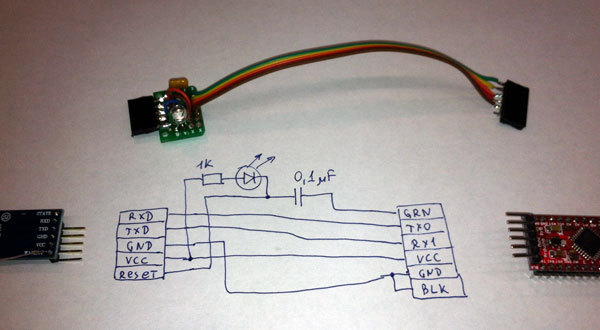
The LED will show an established connection.
On this with soldering everything, but pouring still does not work. The fact is that the Arduino IDE at each attempt to fill the sketch clears the COM port buffers, which causes the BlueTooth connection to be closed and the download canceled.
To avoid this, you need to fix the configuration of the Arduino IDE, which is located in the file C: \ arduino \ hardware \ arduino \ boards.txt . We open this file in a text editor, look for the section corresponding to the board with which we work (I have this Pro Mini 5V) and add the following line:
pro5v328.upload.disable_flushing = true
Do not forget to change the first word in the string, for example, for Arduino Uno it will be:
uno.upload.disable_flushing = true
Now pouring should earn. A small annoying detail remains - when we go into the Arduino IDE menu and select the “Tools” item, the program “freezes” for a few seconds. The fact is that with each access to this menu item, the program goes through all the available COM ports in the system, but in a non-optimal way, which leads to large delays. To remove this delay, you need to replace the rxtxSerial.dll library with a modified version, which can be found here . Who are interested in the details of the problem, may familiarize themselves with the thread on the forum Arduino .
Here is another option with the Arduino TX Power and TX button:

The scheme of the second option (the Bluetooth module is different, so the pins are located differently and the Pro Mini is not original, but “Deek-Robot”, the pinout is mirrored):
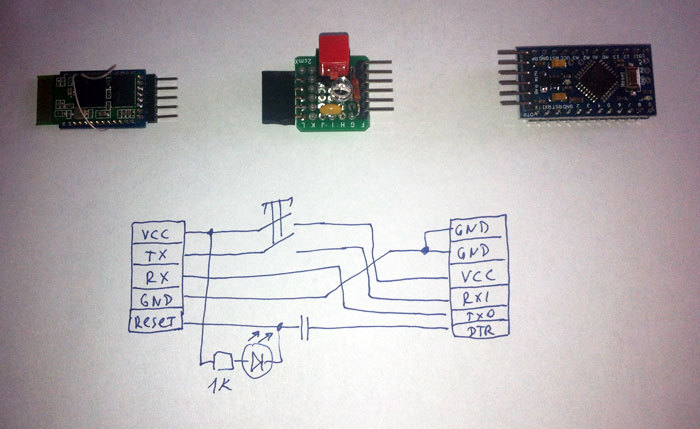
The circuit takes up minimal space, connects quickly, does not require configuration. It also remains possible to enable the Arduino IDE to enable Serial Monitor and receive data from the device as if connected via USB.
PS
It turned out that there are ready-made such converted modules , and maybe someday we will see them on sale in our country.
- Power circuits - switching 220V. One connection error and good-bye to the USB controller of your favorite system unit.
- Radio frequency circuits - a lot of pickups on food.
- Assembled and somewhere fixed devices that it is desirable to reflash, but it is inconvenient to crawl to them.
On the Internet you can find several publications on this topic, but all of them are fragmentary and there is no completely ready solution. Also, despite the simplicity and obviousness of the design, there are several small difficulties that are ready to thwart the whole event. About how to overcome them, I want to talk in this article.

I used the cheapest Bluetooth-modules with the straightforward name "Bluetooth-module HC-05 (HC-06)". On ebay they can be found from 200 rubles. apiece, in domestic stores - from 500 rubles. I advise you to take the module already soldered on the adapter "for the Arduino", the difference in money is minimal, and saves time on assembling the interface circuit.
')

And if you got a module without an adapter card?
In this case, you will have to assemble the adapter circuit yourself. The instruction is here.
We need HC-05, but since it is extremely difficult to visually distinguish them, there is a great chance that HC-06 will be in the hands, even if the package says “HC-05”, as it happened to me:

Is it possible to distinguish HC-05 from HC-06?
You can try to distinguish in appearance, if not all the legs of the Bluetooth module are sealed or have a multimeter at hand. In HC-05 to the LED, unsoldered on the module itself, there is a conductor from leg 31, and in NS-06 from leg 24.
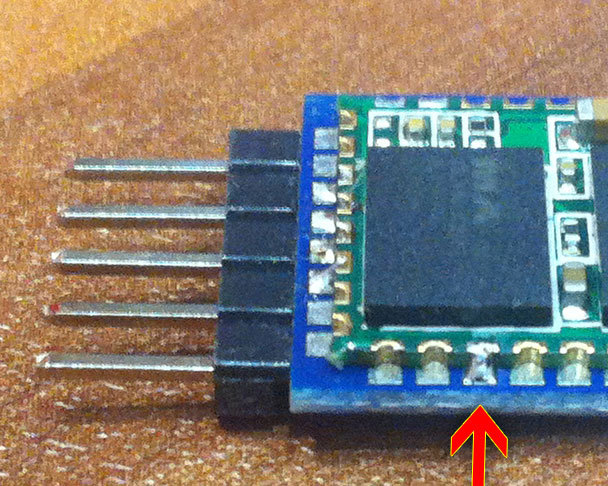
The photo shows that the only 24th leg is soldered on the whole row, it is one hundred percent module HC-06.

The photo shows that the only 24th leg is soldered on the whole row, it is one hundred percent module HC-06.
Fortunately, HC-06 can be reflashed in HC-05, but you will have to find a computer with an LPT port and spend a few hours. Instructions for flashing can be read here . From myself I want to add that the firmware did not take place under Windows7, I had to install Windows XP, and also in the BIOS, change the LPT port mode to EPP 1.7.
Detailed LPT port settings
The switching of LPT-port modes and settings in the Device Manager was especially tiring, so I’ll immediately give you the correct screenshots. BIOS:

In dispatcher:
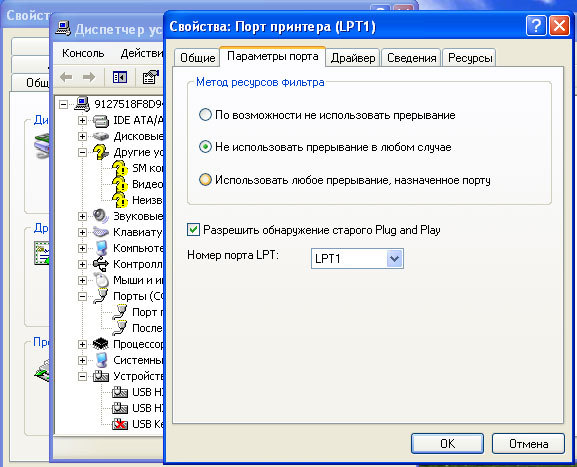

In dispatcher:

Why reflash?
The HC-05 firmware, unlike the HC-06, when connecting, changes the signal at the 32 pin - this is necessary in order to hard reset the programmable Arduino and start the fill process. You can not reflash, and press the RESET button on the board every time before pouring, and you need to catch the right moment, which is extremely inconvenient. It looks like this
So, we have on hand the module HC-05. Now you need to set the parameters of work. To switch to the parameter setting mode, you need to solder the last, 34th leg to the power supply 3.3v.

Then we connect to the computer via any USB-UART-TTL adapter and in the terminal we give the following sequence of commands:
AT
AT + RESET
AT + ORGL
AT + ROLE = 0
AT + POLAR = 1.0
AT + UART = 57600,0,0
AT + INIT
AT + INQ
If you want to change the standard password for pairing, then in addition:
AT + PSWD = 5678
If you want to change the name of the device, then in addition:
AT + NAME = RemoteArduino
After that, the module is turned off, the jumper with 34 legs is removed and proceed to the final refinement of the module. This can be done directly on the HC-05 board, but it seemed to me more convenient to do this in the form of an adapter card for direct connection to the Mini Pro.

To automatically reset the Arduino when a connection is established, you need to bring the 32nd foot to the connector, for this I cut off the WAKE-UP output that was unnecessary for me and labeled it as RESET. The adapter scheme is as follows:

The LED will show an established connection.
On this with soldering everything, but pouring still does not work. The fact is that the Arduino IDE at each attempt to fill the sketch clears the COM port buffers, which causes the BlueTooth connection to be closed and the download canceled.
To avoid this, you need to fix the configuration of the Arduino IDE, which is located in the file C: \ arduino \ hardware \ arduino \ boards.txt . We open this file in a text editor, look for the section corresponding to the board with which we work (I have this Pro Mini 5V) and add the following line:
pro5v328.upload.disable_flushing = true
Do not forget to change the first word in the string, for example, for Arduino Uno it will be:
uno.upload.disable_flushing = true
Now pouring should earn. A small annoying detail remains - when we go into the Arduino IDE menu and select the “Tools” item, the program “freezes” for a few seconds. The fact is that with each access to this menu item, the program goes through all the available COM ports in the system, but in a non-optimal way, which leads to large delays. To remove this delay, you need to replace the rxtxSerial.dll library with a modified version, which can be found here . Who are interested in the details of the problem, may familiarize themselves with the thread on the forum Arduino .
Here is another option with the Arduino TX Power and TX button:

The scheme of the second option (the Bluetooth module is different, so the pins are located differently and the Pro Mini is not original, but “Deek-Robot”, the pinout is mirrored):

The circuit takes up minimal space, connects quickly, does not require configuration. It also remains possible to enable the Arduino IDE to enable Serial Monitor and receive data from the device as if connected via USB.
PS
It turned out that there are ready-made such converted modules , and maybe someday we will see them on sale in our country.
Source: https://habr.com/ru/post/235727/
All Articles